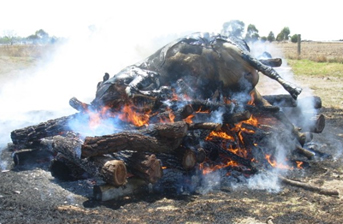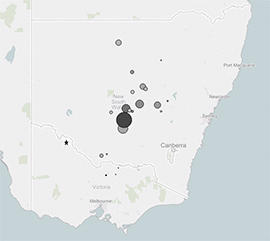Anthrax confirmed in Victorian sheep
The confirmation of anthrax on sheep properties located north-west of Swan Hill in March 2017 is a reminder for veterinarians investigating unexplained sudden deaths.

Anthrax is a zoonotic disease caused by Bacillus anthracis, an aerobic, gram-positive spore-forming bacterium. The spore form of B. anthracis is extremely resilient to heat, drought and chemicals and can remain dormant in the environment for decades.
Grazing herbivores (for example, cattle and sheep) are infected through ingesting spores present in contaminated soils, while browsers (for example, deer) may ingest the pathogen on contaminated foliage. Once ingested, the bacteria produces potent toxins that cause the clinical signs of anthrax, including fever, inappetance, lethargy or sudden death, with a blood-stained exudate visible at the nose, mouth or anus.
However, not all cases of anthrax will discharge visible exudate from the body orifices.
The recent diagnoses highlight the need to think 'anthrax' whenever unexplained sudden death occurs in sheep, cattle or other susceptible species in Victoria, regardless of the location.
Figure 1 shows departmental field staff containing and burning a carcass infected with Bacillus anthracis (2007 outbreak).

Over the last 20 years, Victorian anthrax cases have typically been located within the historic anthrax 'belt', focused particularly in dairy cattle in the Stanhope/Tatura area (see Figures 2 and 3).
Figure 2 shows the location of cases of anthrax in sheep in Victoria and New South Wales since 1950, where depth of colour represents the number of properties affected and circle size represents the number of sheep affected per outbreak, and the star is the 2017 sheep anthrax case

Figure 3 shows the location of cases of anthrax in cattle in Victoria and New South Wales since 1950, where depth of colour represents the number of properties affected and circle size represents the number of cattle affected per outbreak and the star is the 2017 sheep anthrax case

There have been four previous outbreaks of anthrax in Victorian sheep, with the last diagnosis in 1997. However, recent modelling based on environmental and soil type data has found that, if anthrax spores were present, the local environmental conditions could support the survival of these spores in a much wider area across northern Victoria than suggested by historical cases (Figure 4).

Figure 4 shows the predicted geographic distribution of Bacillus anthracis in Australia based on ecological niche modelling (red shading). Blue outline from Victoria to southern Queensland = historical anthrax belt; green outline in NSW = Hunter Valley; light green outline in Victoria = Goulburn Valley (star = 2017 sheep anthrax case).
A screening test for anthrax in the field for cattle and sheep carcasses can be carried out using a hand held immunochromatographic test (ICT). The ICT must be used before a post-mortem is completed or the carcass is moved and can only be used by those who are accredited by Agriculture Victoria.
If you complete an anthrax investigation using an ICT, please notify your local District Veterinary Officer (DVO). If you cannot reach the DVO, ring the Emergency Animal Disease Watch Hotline on 1800 675 888.
Agriculture Victoria will pay a private veterinarian $200 (GST-exclusive) to conduct a basic anthrax exclusion (perform an ICT and report the results to their local DVO).
A positive ICT will require confirmation via submission of a blood sample to AgriBio (Agriculture Victoria, Bundoora) for further definitive testing.
Note: Agriculture Victoria's Significant Disease Investigation (SDI) program producer subsidy does not apply for anthrax investigations.
Once anthrax has been ruled out, subsidies for veterinarians and livestock producers for further investigation may be available under the Significant Disease Investigation (SDI) program.
Please contact your DVO for more information.
Anthrax vaccination
Agriculture Victoria maintains a stock of anthrax vaccine for use in cattle and sheep for use during an anthrax outbreak, with vaccination in this instance carried out free of charge.
Farmers in anthrax-prone areas should contact their local Agriculture Victoria veterinary officer if they wish to undertake voluntary preventive vaccination against anthrax. Vaccination in cattle in anthrax-prone areas is subsidised with farmers paying only $1 per head. The subsidy does not apply where producers wish to send cattle overseas (vaccination for export purposes) or to a feedlot where pre-entry vaccination is a requirement.
More information on subsidies for conducting disease investigations, including sudden death investigations for anthrax, can be found on the Significant Disease Investigation (SDI) program page.
More information on anthrax in Victoria can be found on the Anthrax in animals page.
Reference
Barro A, Fegan M, Moloney B, Porter K, Muller J, Warner S and Blackburn J (2016) Redefining the Australian Anthrax Belt: Modelling the Ecological Niche and Predicting the Geographic Distribution of Bacillus anthracis. PLoS Neglected Tropical Diseases 10(6): e0004689